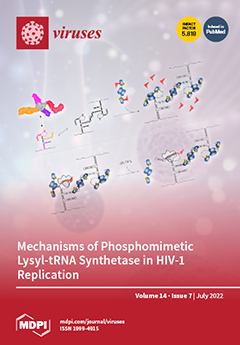Open AccessArticle
SARS-CoV-2 Specific Immune Response and Inflammatory Profile in Advanced HIV-Infected Persons during a COVID-19 Outbreak
by
Alessandra Vergori, Antonio Boschini, Stefania Notari, Patrizia Lorenzini, Concetta Castilletti, Francesca Colavita, Giulia Matusali, Eleonora Tartaglia, Roberta Gagliardini, Andrea Boschi, Eleonora Cimini, Markus Maeurer, Pierluca Piselli, Leila Angeli, Andrea Antinori, Chiara Agrati and Enrico Girardi
Cited by 13 | Viewed by 3211
Abstract
The main aim of this study was to describe the clinical and immunological outcomes, as well as the inflammatory profile, of patients with advanced HIV in an assisted-living facility in which an outbreak of SARS-CoV-2 occurred. SARS-CoV-2 humoral and specific T-cell response were
[...] Read more.
The main aim of this study was to describe the clinical and immunological outcomes, as well as the inflammatory profile, of patients with advanced HIV in an assisted-living facility in which an outbreak of SARS-CoV-2 occurred. SARS-CoV-2 humoral and specific T-cell response were analyzed in patients with HIV infection and COVID-19; as a secondary objective of the analysis, levels of the inflammatory markers (IL-1β, IL-6, IL-8, and TNFα) were tested in the HIV/COVID-19 group, in HIV-positive patients without COVID-19, and in HIV-negative patients with mild/moderate COVID-19. Antibody kinetics and ability to neutralize SARS-CoV-2 were evaluated by ELISA assay, as well as the inflammatory cytokines; SARS-CoV-2 specific T-cell response was quantified by ELISpot assay. Mann–Whitney or Kruskal–Wallis tests were used for comparisons. Thirty patients were included with the following demographics: age, 57 years old (IQR, 53–62); 76% male; median HIV duration of infection, 18 years (15–29); nadir of CD4, 57/mmc (23–100) current CD4 count, 348/mmc (186–565). Furthermore, 83% had at least one comorbidity. The severity of COVID-19 was mild/moderate, and the overall mortality rate was 10% (3/30). Additionally, 90% of patients showed positive antibody titers and neutralizing activity, with a 100% positive SARS-CoV-2 specific T-cell response over time, suggesting the ability to induce an effective specific immunity. Significantly higher levels of IL-6, IL-8, and TNF-α in COVID-19 without HIV vs. HIV/COVID-19 patients (
p < 0.05) were observed. HIV infection did not seem to negatively impact COVID-19-related inflammatory state and immunity. Further data are mandatory to evaluate the persistence of these immunity and its ability to expand after exposure and/or vaccination.
Full article
►▼
Show Figures






